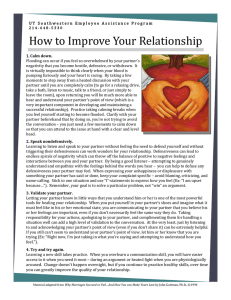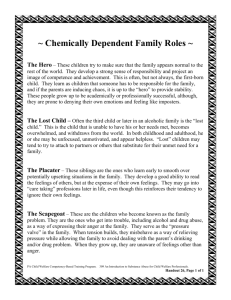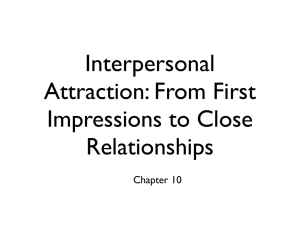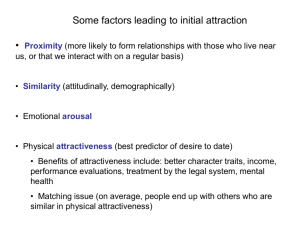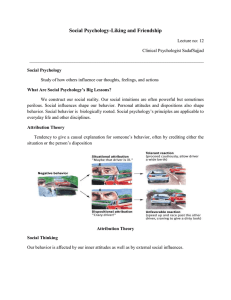Document
advertisement
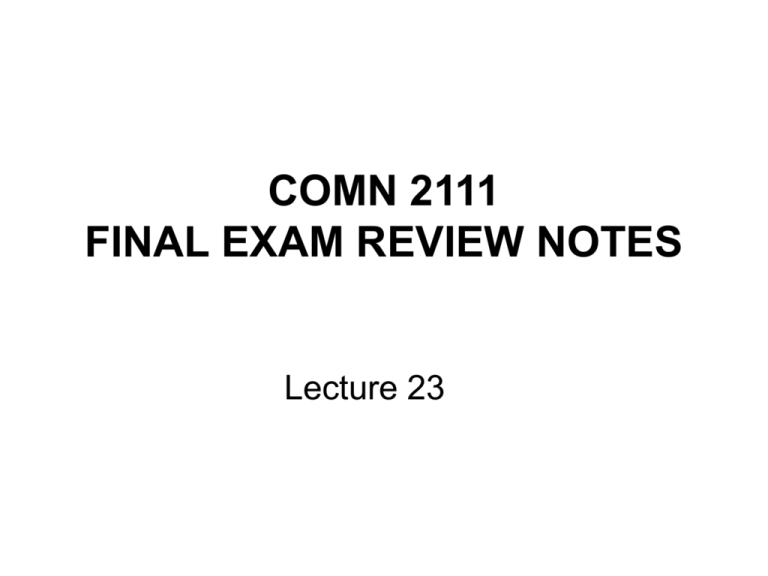
COMN 2111 FINAL EXAM REVIEW NOTES Lecture 23 Please Check the course Home Page Flasher for the date, time and location of the the final exam. Check The Assignments Page for information on the structure of the exam. TWO ICONS TO NOTICE AS I LECTURE • MEANS THIS IS A SHORT ANSWER • MEANS THAT THIS CONCEPT IS SPECIFICALLY REFERRED TO OR COULD BE USED IN AN ESSAY COMMUNICATION EFFECTIVNESS: SKILLS ABOUT SKILLS We often don’t respond effectively to others when we feel challenged Since most of our natural responses are automatic, over-learned, unconscious, we need to be conscious and manage our reactions How? By becoming MINDFUL FLEXIBLE METACOMMUNICATORS IF WE DON’T CONSCIOUSLY MANAGE OUR TALK We automatically enact the 7th axiom of interpersonal communication We speak defensively DEFENDING THE CONCEPTUAL SYSTEM OF THE SELF • DENIAL: REFUSE TO ADMIT THREAT IS RELEVANT TO SELF OR ASSUME IT CAN BE POSTPONED • AVOIDANCE: REFUSING TO FACE THREAT; NOT BEING IN SITUATION WHERE YOU MIGHT HAVE TO DEAL WITH IT • RATIONALIZATION: MOST COMMON: MAKING EXCUSES, EXPLAINING AWAY THREATS • INTELLECTUALIZATION: ENGAGING IN DETACHED ANALYSES OF THREATENING PROBLEMS • PROJECTION: OPPOSITE OF BURYING INSIDE, ATTRIBUTE THREATENING FEELINGS TO SOMEONE ELSE • REGRESSION: REVERT TO EARLIER MORE CHILDLIKE STATE • Selected Readings Book We Fail To Notice Our Emotional Communication Transactional Analysis (TA) TA connects needs to patterns of external behavior Internal ego states produce outward behavior to evoke appropriate response from others: • • • The parent - critical or controlling , standard setting, nuturant The adult - problem solver-information getter The child -spontaneous (+) and (-), little professor, adapted • The words/sounds of the "voices" of the ego states • Chap. 7 textbook • Paralanguage – sound of your voice shapes meaning of words and shows your emotional “position” in an exchange with another We Don’t Give Each Other “Good Information” “Good” – means truthful, accurate, relevant, understandable So we both can make an informed choice And act from commitment not coercion or manipulation WE CHANGE THE EMOTIONAL BIDDING IN OUR CONNECT TALK • TURNING TOWARD: + REACTION TO O’S BID • TURNING AGAINST: - REACTION TO O’S BID • TURNING AWAY: o IGNORE O’S BID Assumptions Behind CONNECT, C.O.N.T.R.O.L. And D.I.A.L.O.G.U.E. Talk Connect Talk Basic agreement, no tension, expectations clear basic agreement, no tension, expectations clear Simple descriptions of other’s behavior and of events Joking, story telling Routine description of self Actions, preferences, opinions, beliefs Voice tone relaxed C.O.N.T.R.O.L. Talk Assumptions I must manage the other or situation to maintain my face I persist - you change My story is obvious and is the truth Truth based on real data - my data I have access to all the data As C.O.N.T.R.O.L. Talk gets heavy I know what you meant – I tell you so You are to blame D.I.A.L.O.G.U.E. Talk Assumptions Solve problem not save face -manage self not other We both have to change My story is my story - obvious only to me You have your story - obvious only to you I have all the data only when I listen to your story As D.I.A.L.O.G.U.E. Deepens You clarify your meaning –I don’t try to do it for you How did we contribute to this situation? STYLE ELEMENTS OF D.I.A.L.O.G.U.E. TALK STYLE ELEMENTS OF C.O.N.T.R.O.L. TALK C. Critical Judgment – I Talk From Critical Judgment of You or Complain about your action O. Offer Them New Information – – – You-Messages: Tell Them Their Story Ask Questions To Probe For Agreement And/Or Understanding Of My Story Listen For Leverage - For Agreement With Me Or Weakness In Their Story N. Negotiate A Change In Them – – No/Low Acknowledgement Of Their Story No/Low Support For Them T. Try Again (Repeat Yourself) Or – – Terminate Talk Or Take It Personally and(Move To Heavy C.O.N.T.R.O.L R. Righteous Anger/Indignation – Strong Emotions Drive Speech O. Overt Aggressive or Passive/Aggressive Talk – You-Messages: Attack Person Not Problem – – – Disguised Emotional Talk Creates Defensiveness Most Often Used As “Put Downs” Or Attacks, Ridiculing Humor L. Lay Blame • • • • • • • Description - communicate valid info I-messages - own your story Asking questions - 4W2H Listening actively -show empathy Open acknowledgement - 4 kinds Genuine support - affirm, feedback Understand First - suspend • judgment Emotional Self-Management -hot to cool • GIVE UNDERSTANDING FEEDBACK – Reflect: paraphrase back to the speaker how you think they think or feel about the subject in order to let them know you’ve really listened. – Ask questions to get more information before you reflect. • AVOID THE FOUR DON’T’S – DON’T tell them what they should be thinking – DON’T tell your story – DON’T give your opinion or advice until they ask – DON’T debate. let them correct your reflection if they need to. I-Messages • Descriptive – Non Judgmental – About your own perceptions, feelings, thoughts • Open Acknowledgements – One of the most powerful I-messages – Build invisible connective bridge between in difficult situations • Acknowledge the other, the situation, your own feelings, etc. Fair Fighting Styles Elements • • • • • • • • Effectively Express Feelings - “I -Messages” Define Out Of Bounds Areas Of Vulnerability - No “Below The Belt” Talk Say What Fight Is About And Stay Inside Limits Focus On The Here And Now Listen Actively - Agree To Paraphrase Other’s Arguments In Your Own Words and Other Does Same Take It With Style Focus On O’s Behavior And Ideas Look For Where You And Other Agree – See How You Can Help Other Get Some Of What They Want MODEL OF CONFLICT MANAGEMENT STYLES HI I M P O R T OF A N C E FORCING COLLABORATING WIN-LOSE G O A L S WIN-WIN COMPROMISING BOTH WIN- BOTH LOSE AVOIDING LO ACCOMMODATING FEAR OF LOSE-LOSE LO IMPORTANCE OF RELATIONSHIP LOSE-WIN HI (Text) Gender and talk - Two views of the world (Lecture and Wood, Selected Readings) Men speak to discover who is in charge - high vs. Lows – competition To establish autonomy relative to each other (compete to maintain it) To negotiate status Using ‘report talk’ Purpose of talk: Talk should accomplish something solve a problem, so give advice, take a stand Their “taken for granted” world is one of hierarchy and control Gender and talk - Continued Women speak to discover who is connected - close vs. Far – connection To establish their connection to each other (cooperate to maintain it) To negotiate intimacy Using ‘rapport talk’ (connect talk) Purpose of talk: Talk should connect people - deal with feelings, personal ideas, build relationships Their “taken-for-granted” world is based on closeness and distance BASES OF HUMAN ATTRACTION • Attraction develops from proximity and similarity in the following situations: • Perceived Reciprocity of Liking • • Attraction to others can depend on whether you feel that the people you like also like you - SIMILARITY Another’s “liking” increases your self-worth you return the compliment with reciprocal liking. • Complementary needs • • Attraction is also somewhat based on COMPLEMENTARITY as well as similarity Dominance/submission, protection/dependence, talk/silence Relationship building: Trust and self-disclosure • The Johari Window OPEN HIDDEN BLIND UNKNOWN Life cycle of relationships Coming together • Initiating • Experimenting • Intensifying • Integrating • Bonding Coming apart • Differentiating • Circumscribing • Stagnating • Avoiding • Terminating GOTTMAN’S MARRIAGE DISSOLUTION CASCADE “Coming Apart” Repeated • Complaining and criticizing leads to • Contempt in sender, which leads to • Defensiveness in receiver which leads to • Listener Withdrawal from interaction (stonewalling). PLEASE GO TO THE LINK FOR THE CASE STUDIES On the way there please fill out my very short course questionnaire Download cases Look at them and then look at this lecture again. Also please go to ratemyprofessor.com ONE LAST VID GOOD LUCK FROM THE MAD PROFESSOR!


